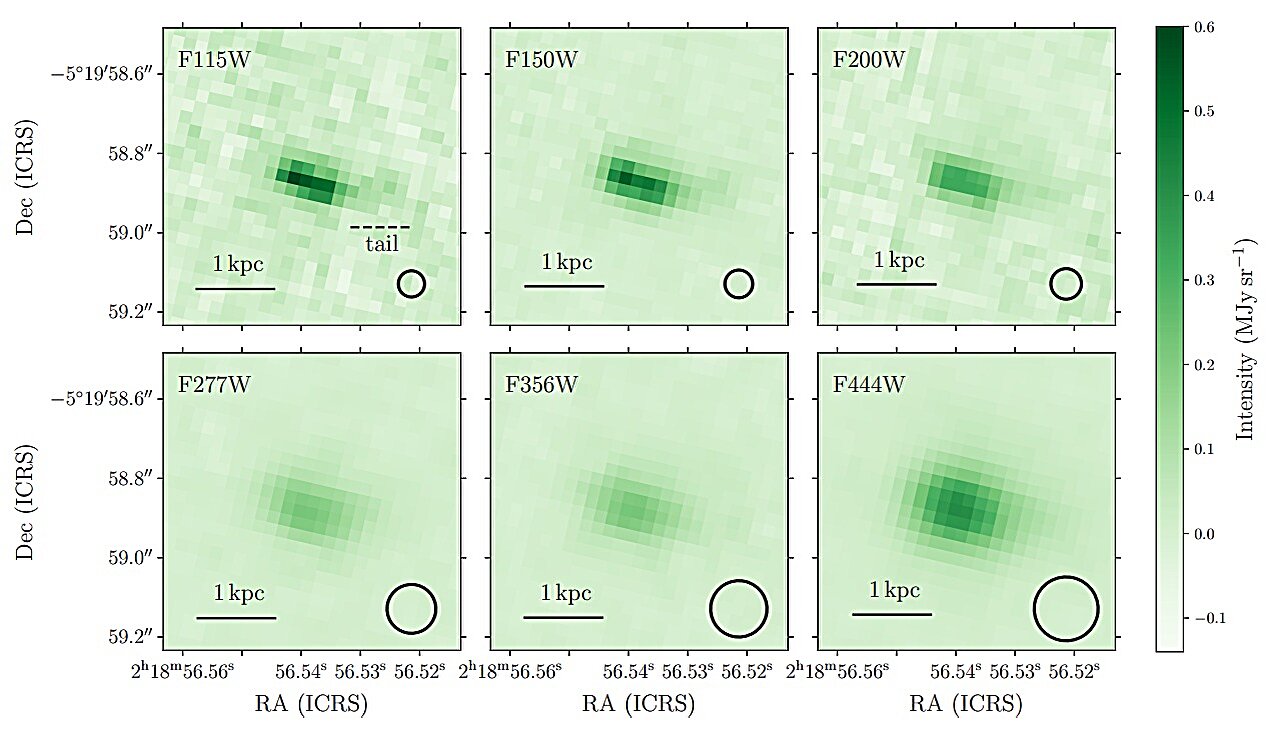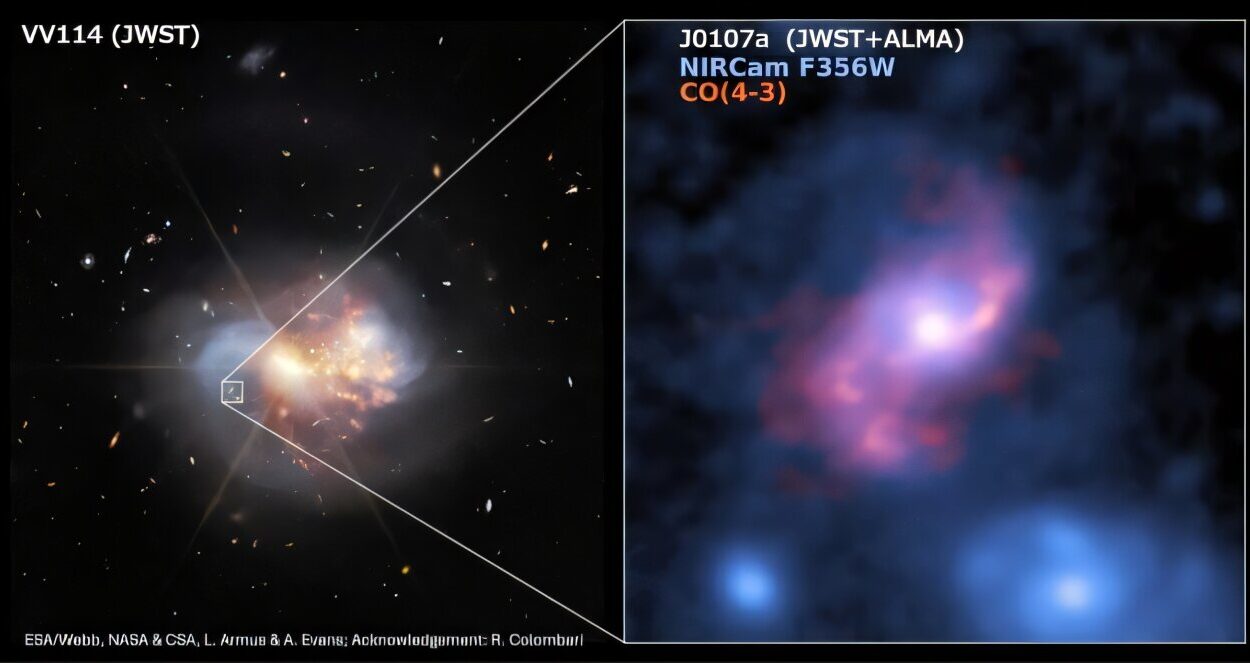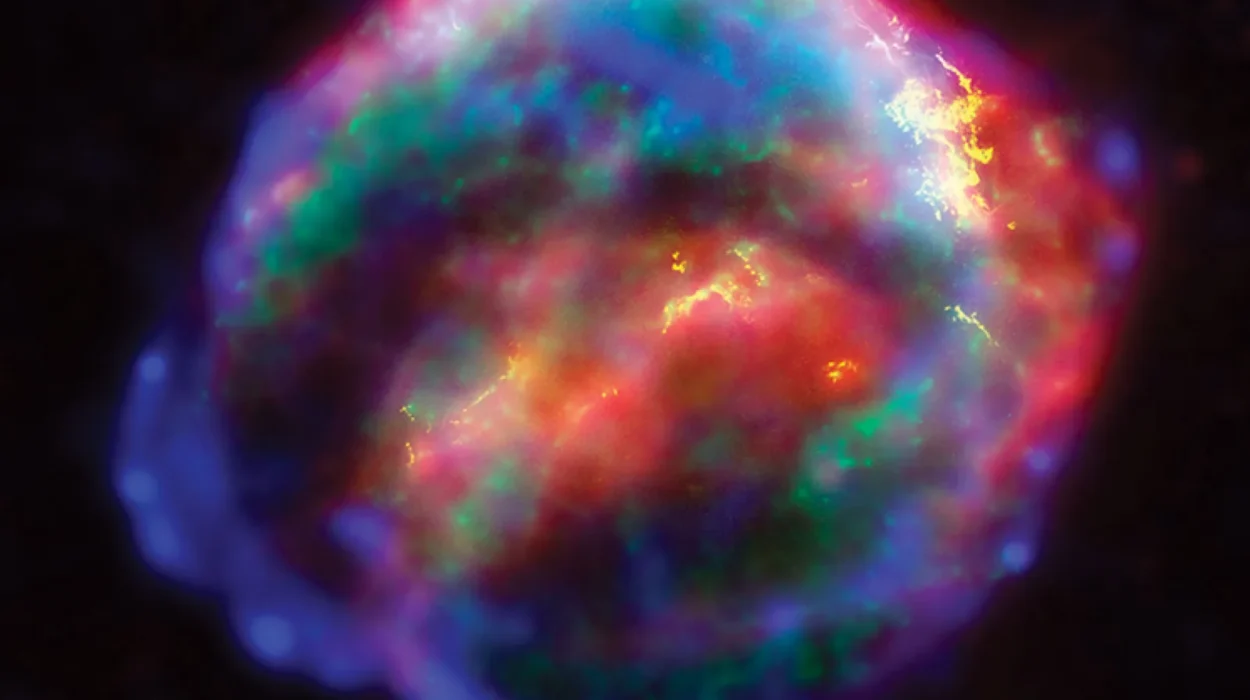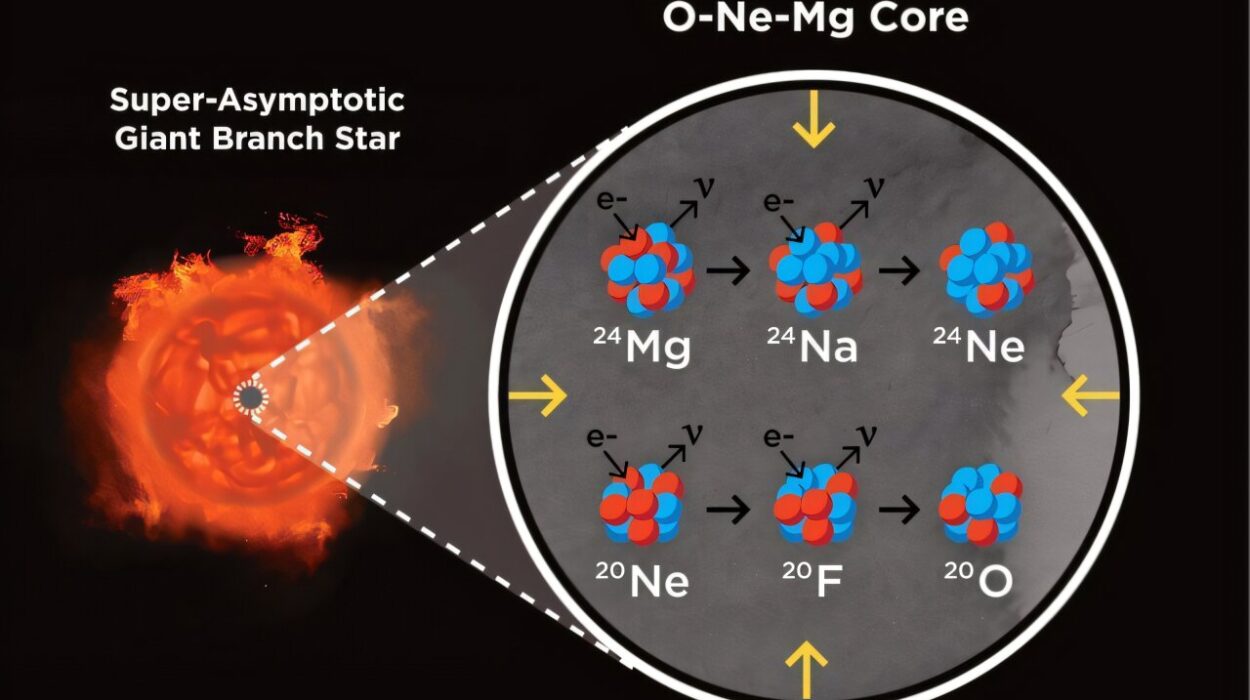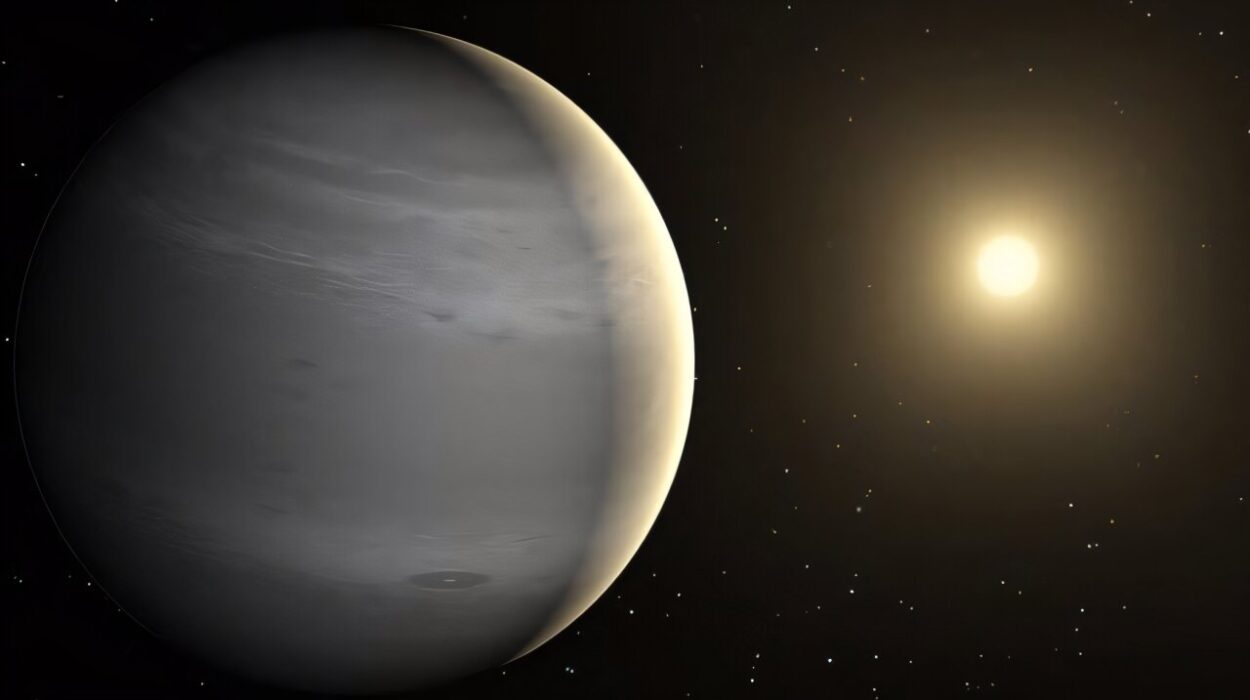Imagine looking back in time—so far back that the light you see began its journey before the Earth even existed. That’s what astronomers accomplished when they turned the James Webb Space Telescope (JWST) toward a faint smudge of light called SXDF-NB1006-2. This galaxy, located about 12.9 billion light-years away, shines from an era when the universe was barely 700 million years old—a mere infant in cosmic terms.
Now, thanks to the remarkable sensitivity of JWST, an international team of astronomers has peeled back the layers of this ancient system, revealing it to be a young starburst galaxy, bursting with new stars and flinging outflows of ionized gas into space. Their findings, published on October 29 on the arXiv pre-print server, offer an extraordinary glimpse into one of the universe’s first great firestorms of creation.
A Galaxy Born in Fire
Discovered in 2011, SXDF-NB1006-2 has long intrigued scientists because of its extreme distance and its apparent youth. Early studies hinted that it was a starburst galaxy—a system undergoing an intense, short-lived period of star formation. But exactly what drove its evolution remained mysterious.
Led by Yi W. Ren of Waseda University in Tokyo, Japan, the research team set out to uncover its secrets. They used two of JWST’s most powerful instruments: the Near Infrared Camera (NIRCam) and the Near Infrared Spectrograph (NIRSpec). Together, these tools allowed the astronomers to see SXDF-NB1006-2 in exquisite detail, capturing both its shape and the spectral fingerprints of its glowing gases.
Their observations confirmed that this galaxy is astonishingly young—only about two million years old, a cosmic newborn glowing with the energy of creation. In those few million years, it has already begun producing stars at a breathtaking pace: around 38 times the mass of our Sun every year.
A Clumpy, Chaotic Beauty
The images from JWST revealed something striking. The ultraviolet light from SXDF-NB1006-2 doesn’t form a neat, spiral shape like the Milky Way. Instead, it appears elongated and clumpy, with a tail-like structure stretching into the darkness. This unusual form suggests that the galaxy might be seen edge-on, or perhaps that it is a “chain galaxy”, a string of star-forming knots bound together.
Even more intriguing, the oxygen emission—light produced when oxygen atoms are excited by energetic radiation—also shows a clumpy, tail-like pattern. This kind of structure is often a signature of galactic mergers, violent cosmic collisions where two smaller galaxies crash together and merge into one. If true, SXDF-NB1006-2 may have formed from just such a union, a turbulent coming-together that sparked its current starburst phase.
Winds from the Stars
Among the most exciting findings was the detection of a broad component in the oxygen emission line, stretching across an astonishing 6,000 light-years. This indicates that powerful outflows of ionized gas are streaming out of the galaxy—winds driven by the intense energy of young, massive stars and possibly by supernova explosions.
These outflows are more than just spectacular fireworks. They play a crucial role in shaping galaxies, regulating star formation, and enriching the surrounding space with heavier elements. In the early universe, such winds may have helped clear away the dense fog of hydrogen gas, allowing the first galaxies and quasars to shine through.
In the words of the researchers, these ionized outflows are the fingerprints of a “bursty star-formation phase,” a period when the galaxy rapidly consumes its gas to form stars, only to blow much of that gas away through stellar feedback.
The Ingredients of Creation
Every galaxy is a balance between matter, energy, and time. For SXDF-NB1006-2, JWST’s data paint a vivid picture of its composition and fate. The team estimates that it contains about 19.3 billion solar masses of gas, with a metallicity—the abundance of elements heavier than hydrogen and helium—of about 0.2 times that of the Sun.
This relatively low metallicity fits perfectly with its age. The first generations of stars were made almost entirely of hydrogen and helium, the basic elements formed in the Big Bang. Only after these stars lived and died did they enrich the cosmos with heavier elements like oxygen, carbon, and iron. Thus, SXDF-NB1006-2 represents a bridge between those primordial systems and later, more chemically complex galaxies like our own.
The galaxy’s gas depletion time—the time it would take to exhaust its gas if it continues forming stars at the current rate—is estimated at about 144 million years. That’s remarkably short in cosmic terms, suggesting that SXDF-NB1006-2 will burn bright and fast before fading into a quieter, more stable phase.
A Glimpse of Galactic Evolution
The astronomers believe that SXDF-NB1006-2 may be destined to become one of the massive quiescent galaxies observed at redshifts around z = 4 to 5, corresponding to about 1.2 billion years after the Big Bang. These are ancient systems that have long ceased forming stars, existing as silent stellar graveyards in the early universe.
In other words, SXDF-NB1006-2 may be witnessing the birth of a galaxy that will soon fall silent—a young starburst blazing briefly before its light settles into the slow glow of aging stars. Its story offers a living snapshot of how galaxies grow, evolve, and transform in the cosmic web of time.
As the authors put it, “The derived gas depletion time of a few hundred million years implies that our target could be one of the progenitors of massive quiescent galaxies at z ∼ 4–5 identified by recent JWST observations.”
The Power of JWST’s Vision
The James Webb Space Telescope has revolutionized our ability to see the distant universe. With its immense mirror and infrared sensitivity, JWST can peer through dust, detect faint galaxies from the dawn of time, and analyze their light with unprecedented precision.
In the case of SXDF-NB1006-2, JWST’s NIRCam revealed the galaxy’s intricate shape, while NIRSpec dissected its light into spectra, exposing the fingerprints of elements and the motions of gas within. Together, these instruments are helping astronomers reconstruct how galaxies like this one formed and evolved—how the first luminous structures assembled, ignited, and began to shape the universe we see today.
Each observation is a piece of a vast cosmic puzzle. By studying distant galaxies like SXDF-NB1006-2, scientists are effectively turning back the pages of history, tracing the story of creation itself—from the first atoms to the grand galaxies that fill the night sky.
The Cosmic Dawn Comes Alive
When we look at SXDF-NB1006-2, we are witnessing the universe awakening. This galaxy’s light began its journey nearly 13 billion years ago, traveling across expanding space to reach JWST’s golden mirrors. In that light lies the memory of cosmic dawn—the era when the first galaxies emerged from darkness, and starlight began to pierce the ancient fog.
The story of SXDF-NB1006-2 is not just a scientific discovery; it is a human triumph. It is the story of curiosity stretching across centuries and light-years, of minds that refuse to stop asking how we came to be. It reminds us that every faint glimmer in the night sky is a message from the past, a whisper from the universe telling us how it became what it is today.
The Endless Story of Discovery
SXDF-NB1006-2 is just one galaxy among billions, yet in its flickering light we find an echo of our own beginnings. It teaches us that creation is not a single moment but a continuous process—chaotic, fiery, and profoundly beautiful.
As JWST continues to gaze deeper into the cosmos, it will find more galaxies like this one—young, restless, and full of promise. Each will bring us closer to understanding how the universe evolved from a sea of hydrogen into a cosmos rich with stars, planets, and the ingredients of life.
In the glow of SXDF-NB1006-2, we see not just a distant galaxy, but the reflection of our own cosmic origins. We are, after all, the children of such galaxies—born from their dust, illuminated by their light, and carried forward by their legacy.
Through the eyes of JWST, we are finally seeing where we came from—and how the universe, in all its brilliance, began to shine.
More information: Ren et al, RIOJA. Young Starburst and Ionized Gas Outflows in a z = 7.212 Galaxy Uncovered by JWST NIRCam and NIRSpec Observations, arXiv (2025). DOI: 10.48550/arxiv.2510.25721
